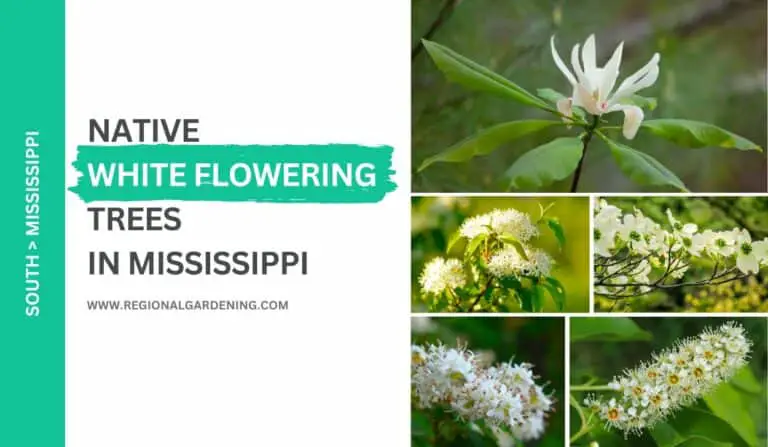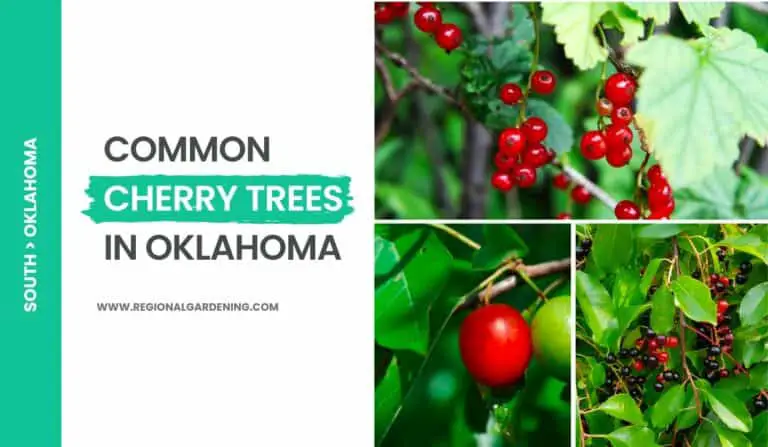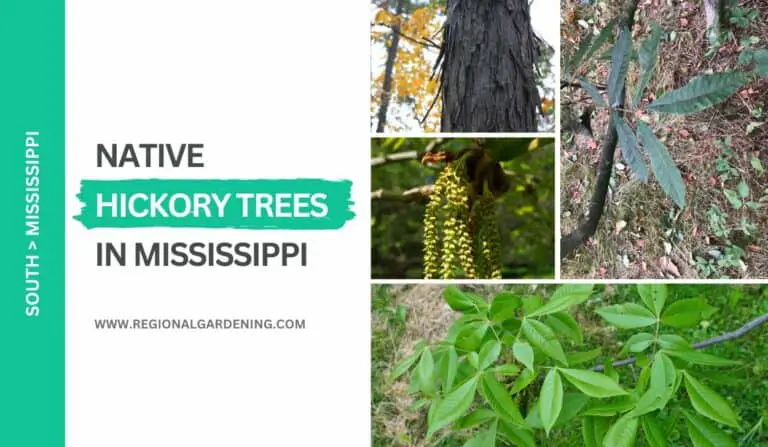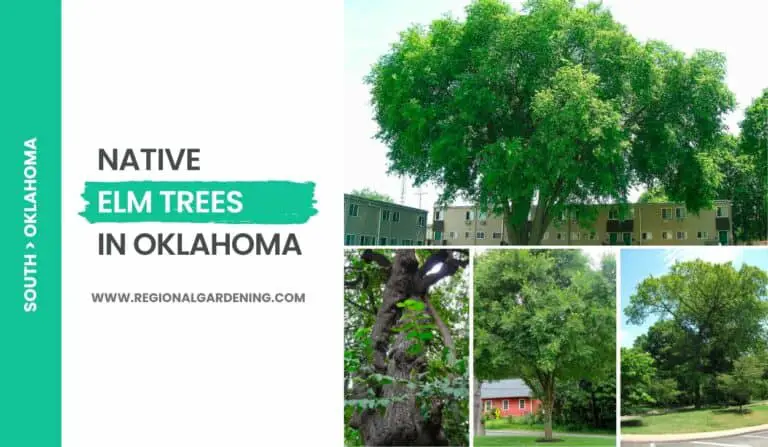16 Native Oak Trees In Oklahoma (Photos & Identification)
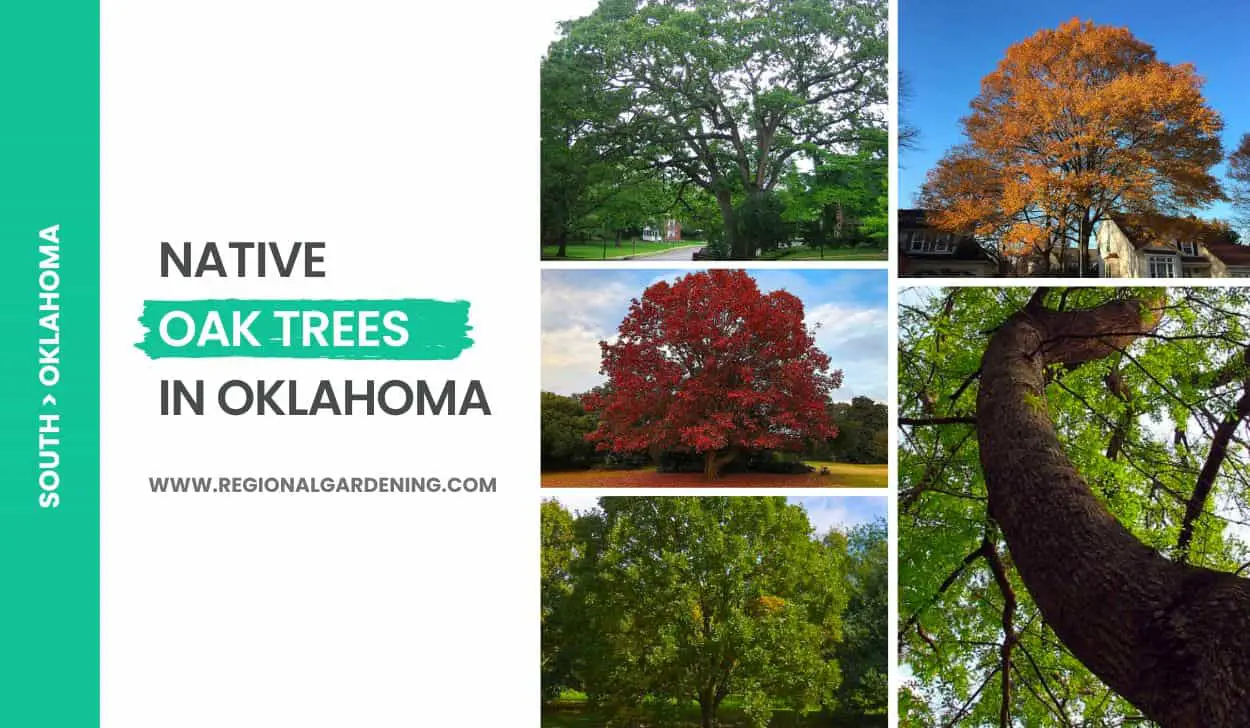
Oklahoma has a diverse array of oak trees that grace its landscape, from the vast plains to the rolling hills and valleys that dot the state. Some of these majestic trees have deep historical roots in Oklahoma’s story, while others have recently arrived, adding to the rich tapestry of the state’s natural heritage.
In this article, we will explore the details of 16 prevalent oak trees in Oklahoma. These oaks provide not only visual appeal but also significant ecological importance from the northern reaches bordering Kansas to the southern expanses near Texas.
With each oak species we encounter, we will uncover the individualistic traits that set them apart.
So, let’s begin.
1. Black Oak
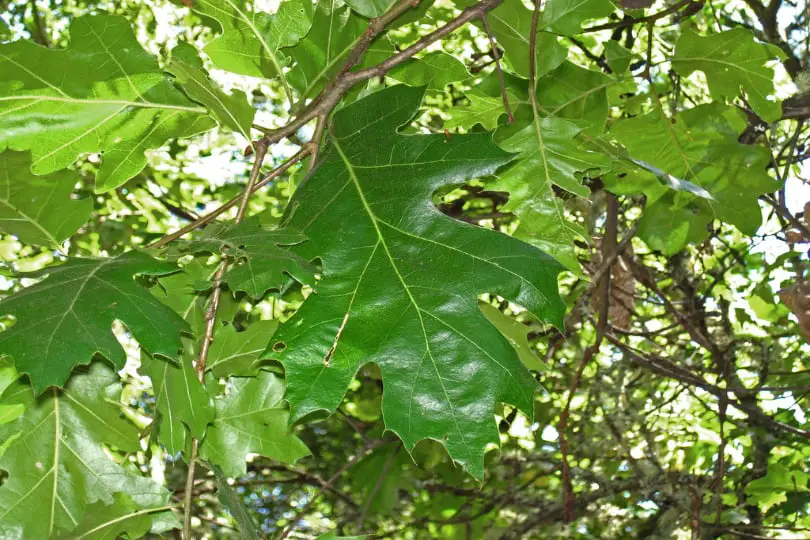
- Scientific Name: Quercus velutina Lam.
- Common Name(s): Black Oak
- Mature Height: 60 feet (18 meters)
- Native Region: Eastern part of the State of Oklahoma
- Flowers: No Flowers
- Fruit: The fruit is a light-brown nut that is from one-half to 1 inch long, more or less hemispherical, and enclosed in a thin, dark brown, scaly cup.
- Uses: The wood of the black oak is hard, heavy, and coarse-grained. It is used for the same purposes as red oak and is commonly put on the market under the name red oak. The inner bark has a bright yellow color and a bitter taste due to tannic acid.
The Black Oak, scientifically known as Quercus velutina Lam., is a huge oak that can reach heights of 60 feet and diameters of 1 to 3 feet. It is mostly found in eastern Oklahoma, especially on dry plains and mountains, but it is rarely observed on rich land. The crown of the tree is irregularly shaped and wide, with a clear trunk reaching up to 20 feet or more on larger trees.
On young trunks, the bark of the Black Oak is smooth and dark brown, but it soon becomes thick and black, with deep furrows and jagged broken ridges. The vivid yellow color and bitter taste of the inner bark, which is linked to the presence of tannic acid, characterize this tree.
The leaves of the Black Oak are alternating, and simple, and range in length from 5 to 10 inches and breadth from 3 to 8 inches. They can be shallow or deeply lobed, with a wide range of shapes. When mature, the leaves are dark green and lustrous on the top, pale underside, and coated in down, with prominent rusty brown hairs in the vein forks.
The Black Oak produces fruit in the form of light-brown nuts during the second season. These nuts are small, measuring half an inch to an inch in length, and have a hemispherical form. They’re wrapped in a scaly, dark-brown cup. The nut kernels are yellow and exceedingly bitter.
The timber properties of the Black Oak are hard, hefty, and coarse-grained. It has a vivid red-brown color with a narrow outside margin of paler sapwood. The wood is widely used for the same applications as red oak and is commonly sold as such. It is crucial to note, however, that the tree’s growth pace is relatively modest.
Because of its distinct physical traits, the Black Oak can be an attractive addition to Oklahoma settings. It is visually beautiful due to its unevenly formed crown and transparent trunk.
Furthermore, its adaptation to arid plains and ridges makes it suited for Oklahoma’s eastern region. This tree does not produce blooms, but it does produce fruit in the form of nuts, which adds to its beauty.
It is advised that Black Oak trees be given ample sunlight and have well-drained soil. Pruning regularly can assist preserve a clear trunk and produce a well-shaped crown.
Additionally, establishing a regular watering and fertilizer schedule might aid in healthy growth. Similar to red oak, the wood of the Black Oak is widely utilized for a variety of reasons, and its inner bark contains tannic acid, which has medicinal and dye-making applications.
2. Bur Oak
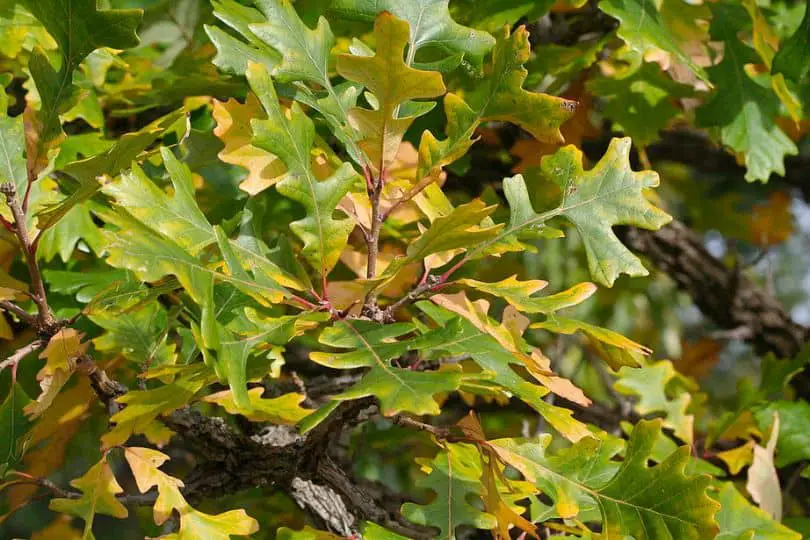
- Scientific Name: Quercus macrocarpa Michx.
- Common Name(s): Burr Oak, Mossy Cup Oak
- Mature Height: 80+ feet (24+ meters)
- Native Region: North America
- Flowers: No flowers
- Fruit: The fruit, or acorn, is a nut set deep in the fringed cup. It is usually one inch or more in diameter but varies in size.
- Uses: The wood of the Burr Oak is heavy, hard, strong, tough, and durable, making it suitable for lumber, cross ties, and fuel.
The Burr Oak, also known as the Mossy Cup Oak, is a big and stately tree that may grow to be over 80 feet tall and have a diameter of 5 feet or more.
Except in the Panhandle region, it is typically found in rich bottomlands along streams or on hillsides along spring-fed ravines across Oklahoma. The term “burr oak” comes from the fringe that surrounds the cup of its big acorn.
This oak tree has a large crown, massive spreading branches, and a short trunk. Its leaves are similar to those of the ordinary white oak, but much larger, measuring 6 to 12 inches long and 3 to 6 inches wide. The leaves contain two large indentations near the base and wavy notches on the middle and upper parts. Burr Oak bark is light gray and breaks up into small narrow flakes.
The Burr Oak is not often found in a forest stand, but rather as a solitary tree or in open stands in fields. It grows best in damp, well-drained soil. The wood of the tree is highly prized for its characteristics: it is heavy, hard, robust, tough, and durable. As a result, wood is useful for a variety of applications, including timber, cross ties, and fuel.
The Burr Oak may be a wonderful shade tree in Oklahoma landscapes, with a vast canopy of branches and leaves. Its magnificent appearance and vast stature make it a center point in any landscape. The tree is also important to wildlife since its nuts provide food for animals.
To properly care for a Burr Oak in Oklahoma, it should be planted in moist but well-drained soil. Water the tree regularly, especially during dry months. Pruning is necessary to remove any dead or diseased branches and to keep the tree in form. Mulching around the base of the tree might aid in moisture retention and weed control.
3. Live Oak
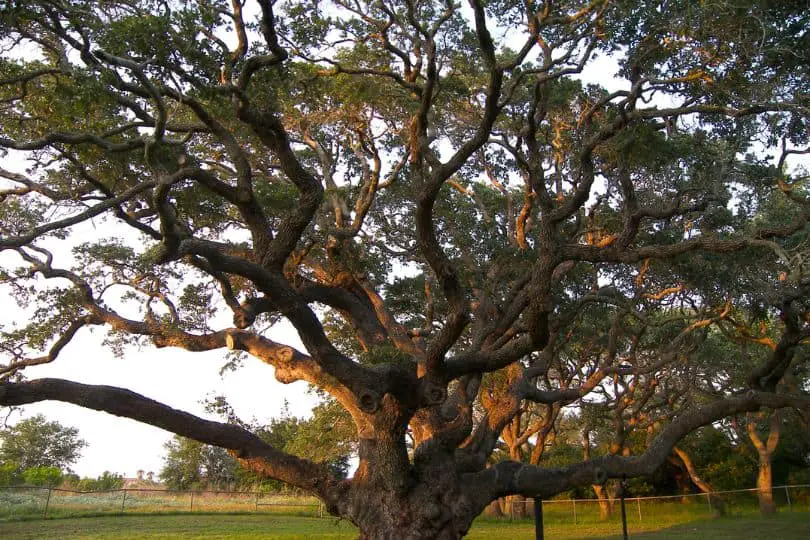
- Scientific Name: Quercus virginiana
- Common Name(s): Live Oak, Southern Live Oak
- Mature Height: 40-80 feet (12-24 meters)
- Native Region: Southeastern United States
- Flowers: No Flowers
- Fruit: Acorns
- Uses: Beautiful shade tree, can be used as a street tree or in parks and gardens, provides habitat for wildlife, and wood is used for furniture and flooring.
Live Oak (Quercus virginiana) is a majestic and iconic tree native to the southeastern United States. It is commonly found in Oklahoma landscapes due to its adaptability to various soil conditions and climates. Live oaks are known for their striking appearance and ability to provide ample shade with their wide-spreading branches.
These oak trees have a mature height range of 40 to 80 feet (12 to 24 meters). They have a broad, rounded canopy that can span up to 100 feet (30 meters), creating an impressive presence in the landscape. The bark is dark gray and deeply furrowed, adding to its overall rugged and sturdy appearance.
Live oaks are well-suited for Oklahoma’s climate, as they are highly drought-tolerant and can withstand extreme temperature fluctuations. They thrive in full sun to partial shade and prefer well-draining soil. Once established, they require minimal maintenance, making them an ideal choice for homeowners and landscapers.
While Live oaks do not produce showy flowers, they are known for their abundance of acorns, which serve as a valuable food source for wildlife. The acorns are about 1 inch (2.5 cm) long and have a round shape. Their dark green foliage provides year-round interest, as the leaves remain green throughout the winter.
In addition to their aesthetic appeal, Live oaks have various uses. They are commonly used as shade trees in residential and commercial landscapes, providing a cool respite during hot Oklahoma summers. They can also be planted as street trees or in parks and gardens. The strong and durable wood of Live Oaks is valued for furniture, flooring, and other woodworking purposes.
To care for a Live oak in an Oklahoma landscape, it is important to provide regular watering, especially during dry periods. Mulching around the base of the tree helps retain moisture and suppress weeds.
Pruning should be done in late winter or early spring to remove dead or damaged branches and maintain a balanced canopy.
4. Blackjack Oak
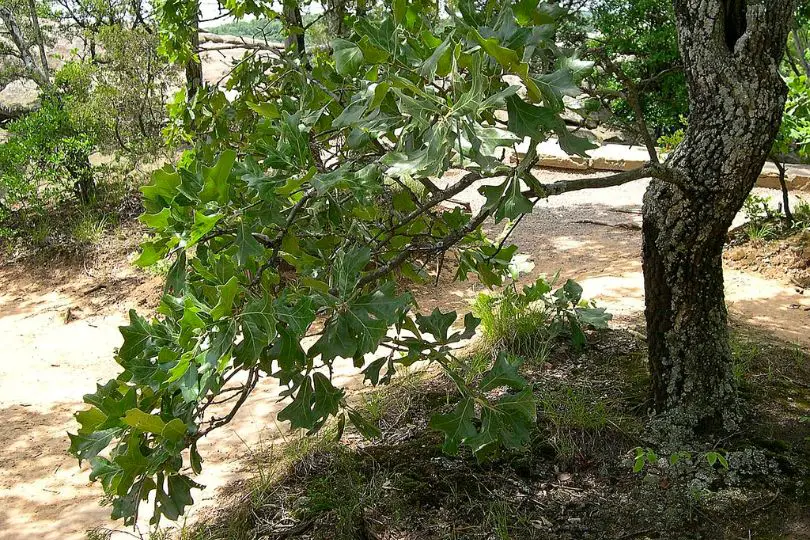
- Scientific Name: Quercus marilandica Muench.
- Common Name(s): Black Jack Oak
- Mature Height: 50-60 feet (15-18 meters)
- Native Region: Throughout Oklahoma
- Flowers: No Flowers
- Uses: Firewood and charcoal.
The Black Jack Oak, also known as Quercus marilandica Muench., is a common tree in Oklahoma. Because it tends to thrive on dry or poorly drained gravelly, clay, or sandy highland soils where few other forest trees can grow, it is known as an indicator of poor soil conditions. The tree’s resistance to poor soil conditions often results in delayed development.
Black Jack Oak can be found in most areas of Oklahoma that sustain natural tree growth. It can grow to heights of 50-60 feet and diameters of 16 inches, but it is normally much smaller. The tree’s limbs are rigid, stiff, and drooping, forming a dense crown with many persistent dead twigs. The bark is tough, dark, and often nearly black, with small, hard scales or flakes.
The leaves of the Black Jack Oak have a leathery texture and are dark green on top and paler beneath. They are widely wedge-shaped and range in length and width from 4 to 10 inches. The tree’s fruit is an acorn about three-quarters of an inch long. The acorns are yellow-brown and often striped, with a broad, light-brown cup surrounding them for half their length or more.
The wood of the Black Jack Oak is heavy, hard, and sturdy, but it is not long-lasting when exposed to soil. It is mostly used to store firewood and charcoal. This oak species can give valuable shade in landscapes due to its dense crown. However, because of its slow growth and predilection for poor soil conditions, it may be less suitable for fast-growing or fertile environments.
5. White Oak
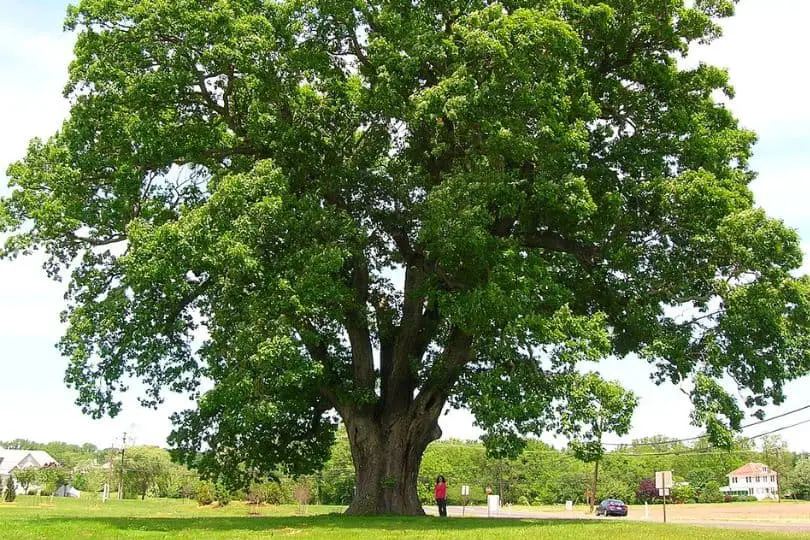
- Scientific Name: Quercus alba L.
- Common Name(s): White Oak
- Mature Height: 60 to 100 feet (18 to 30 meters)
- Native Region: Eastern half of the United States
- Flowers: No Flowers
- Fruit: Light brown nut, three-quarters to one inch long, enclosed in a warty cup
- Uses: Construction, shipbuilding, tight cooperage, furniture, wagons, implements, interior finish, flooring, fuel.
The white oak (Quercus alba L.) is a valuable wood tree found throughout the eastern portion of the United States. It normally grows to a height of 60 to 100 feet, with some examples reaching much greater heights. The white oak can adapt to a wide range of soil conditions and thrives in both thick and open stands. When planted in thick stands, it generates a straight trunk with few side branches, however, when grown in open places, it forms a broad crown with far-reaching limbs, giving it a lovely appearance.
White oak leaves are alternating, simple, and deeply split into 5 to 9 rounded, fingerlike lobes. While unfolding, the juvenile leaves are a delicate silvery gray, yellow, or red tint, which eventually changes into a vivid green above and a paler shade below. The tree bears light brown nuts that range in size from three-quarters to one inch in length and are enclosed in a warty cup. Pigs and other cattle enjoy these nuts.
The wood of the white oak is extremely expensive and versatile. It is heavy, strong, hard, durable, and fine-grained, making it suitable for a wide range of uses. The light brown wood is used for building, shipbuilding, tight cooperage, furniture, carts, utensils, interior finish, flooring, and fuel. Despite its slow growth, the white oak is highly valued for planting in forests, highways, and decorative areas.
With proper care, white oak trees may thrive in Oklahoma landscapes. They prefer well-drained soil and direct sunlight. During dry periods, regular irrigation is required, especially in the first few years after planting. Mulching around the base of the tree might aid in moisture retention and weed control. Pruning should be done in late winter or early spring to remove dead or diseased branches and keep the tree balanced. A balanced slow-release fertilizer applied regularly can support healthy development.
White oak trees, with their stunning look and adaptable timber, provide beauty and value to Oklahoma landscapes. They offer wildlife shade and habitat, making them a good choice for both aesthetic and utilitarian reasons. The white oak is a useful asset to any Oklahoma environment, whether utilized for building, furniture manufacture, or simply as a shade tree.
6. Pin Oak
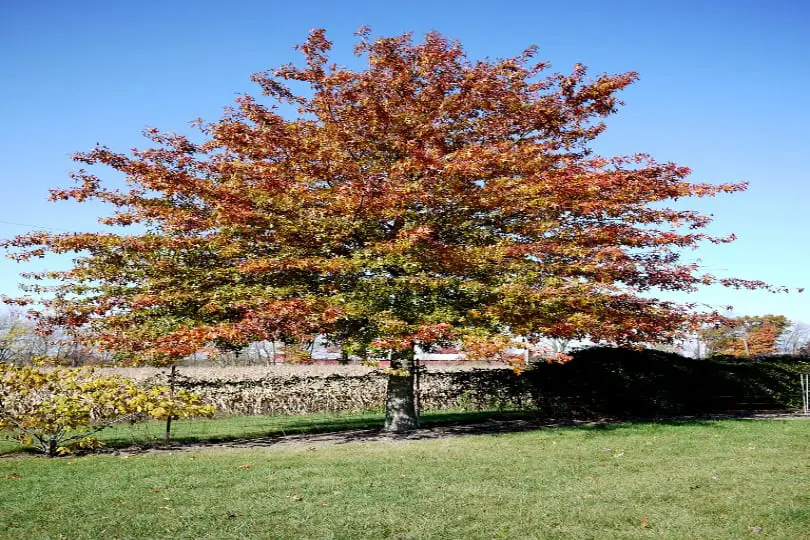
- Scientific Name: Quercus palustris Muench.
- Common Name(s): Pin Oak
- Mature Height: 50 to 70 feet (15 to 21 meters)
- Native Region: Northeastern United States, including Oklahoma
- Flowers: No Flowers
- Fruit: Acorn, nearly hemispheric, light brown, often striped, enclosed only at the base in a thin, shallow, saucer-shaped cup.
- Uses: Pin Oak is commonly used as a street tree due to its beauty, hardiness, and rapid growth. The wood is heavy, hard, and strong, commonly used for various woodworking purposes.
Pin Oak (Quercus palustris Muench.) is a deciduous tree native to the bottomlands and swamp boundaries of northeastern Oklahoma and the eastern United States. It is uncommon in any particular location and is usually found scattered among other tree species. Pin oaks normally grow to heights of 50 to 70 feet, although trees can occasionally grow to be larger, with diameters of up to 2 feet. The tree has an erect stem and many long branches, with the lower branches drooping, the middle branches horizontal, and the upper branches ascending. The tree’s distinctive appearance is due to the abundance of little bristled twigs and branches.
Young pin oak stems have smooth, shiny, light brown bark, whereas elderly trunks have a light gray-brown tint and are covered by thin, tight scales. Pin oak leaves are similar to red oak leaves but are significantly smaller, measuring 3 to 5 inches long and 2 to 4 inches wide. The circular holes in the leaves are not as close to the midrib as those in red oak leaves.
On the same tree, pin oak develops two types of flowers that appear after the leaves are roughly one-third grown. These flowers, however, are not extremely showy. The pin oak’s fruit is an acorn that takes two years to mature. The acorns are nearly hemispheric in shape, about half an inch long, light brown, and frequently striped. They are merely encased at the bottom in a thin, shallow saucer-shaped cup.
Pin oak wood is heavy, durable, and sturdy, making it appropriate for a variety of woodworking applications. It has a light brown tint with thin, darker sapwood. Although the wood is sold and used in the same way as red oak, it is often thought to be of poorer quality.
Because of its beauty, resilience, and relatively quick development, pin oak is widely prized as a street tree in Oklahoma landscaping. It thrives in the rich, damp soil found in bottomlands and swamps.
Pin oak requires constant watering to stay healthy and vigorous, especially during dry years. It is critical to allow enough space for its root system and to ensure that the soil drains effectively. Regular pruning may be required to keep the ideal form and structure.
7. Post Oak
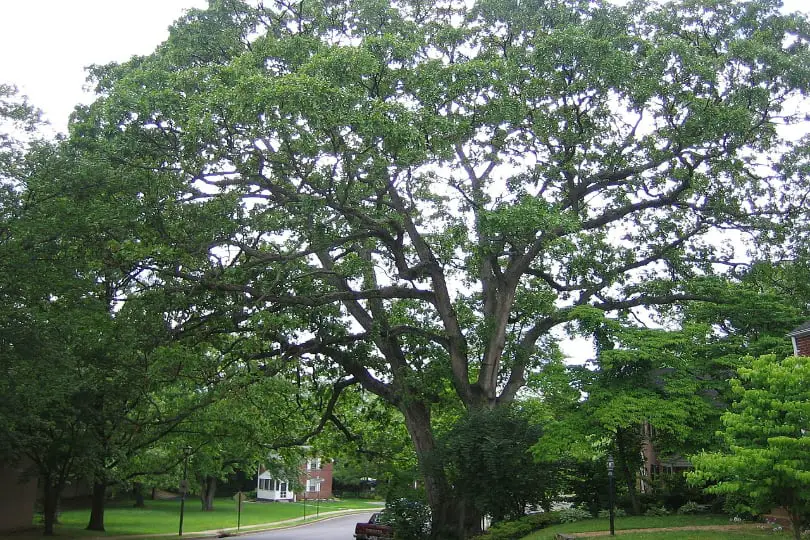
- Scientific Name: Quercus stellata
- Common Name(s): Post Oak
- Mature Height: 50 to 60 feet (15 to 18 meters)
- Native Region: Eastern half of Oklahoma and scattered over parts of the western half
- Flowers: Male flowers in drooping, clustered catkins; female flowers inconspicuous
- Fruit: Oval acorn, 1/2 to 1 inch (1.3 to 2.5 cm) long, set in a small cup
- Uses: The wood of the post oak is heavy, hard, and durable in contact with the soil, making it suitable for crossties, fence posts, and construction work.
The post oak (Quercus stellata) is a medium-sized tree that typically grows to a height of 50 to 60 feet with a diameter of 1 to 2 feet, though it can grow larger. It is most common on poorer soils and can be found across Oklahoma’s eastern half, with sporadic populations in the western half.
The bark of the post oak is rougher and darker than that of the white oak, and it is divided into smaller scales. The leaves are strongly 5-lobed with broad rounded divisions and are normally 4 to 5 inches long and about as wide.
They have a thick, leathery texture with a dark green, lustrous upper surface and a lighter green, rough hairy underside.
On the same tree, the post oak produces two varieties of blooms. Male flowers occur in drooping, grouped catkins, while female flowers are hidden. The fruit of the post oak is an oval acorn that ranges in size from half an inch to one inch and is set in a tiny cup.
The wood of the post oak is strong, robust, and close-grained, with a light to dark brown color. It is especially tough when in contact with soil, making it useful for crossties, fence posts, and construction work. Aside from its economic value, the post oak provides essential natural habitat and food source for a variety of animals.
The post oak is an excellent choice for individuals searching for a medium-sized tree with a rounded crown in Oklahoma landscapes. It grows well in a wide range of soil conditions, including poorer soils, making it suited for a variety of landscapes.
It is well-adapted to Oklahoma’s environment and, if established, can withstand drought conditions. Regular watering during the establishing stage is recommended, as is thorough watering on occasion during prolonged dry spells.
Choose a site in your garden that receives full sun when planting a post oak. The tree grows slowly and can provide shade and ornamental value to your yard. When the tree is dormant in late winter or early spring, prune it to remove any dead or broken branches and keep the ideal shape.
Mulching around the base of the tree regularly will assist retain moisture and prevent weed growth.
8. Northern Red Oak
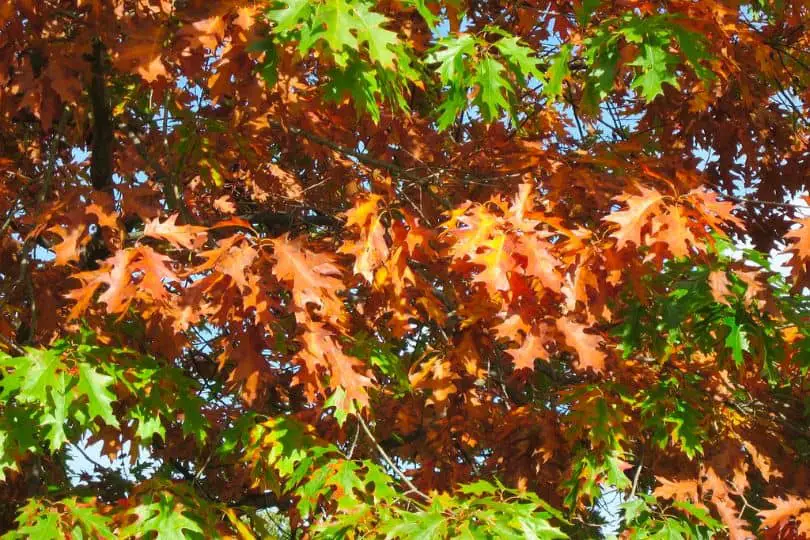
- Scientific Name: Quercus borealis Michx. f.
- Common Name(s): Northern Red Oak, Mountain Water Oak
- Mature Height: 70 feet to larger sizes
- Native Region: Eastern part of the state, commonly found in the mountains
- Flowers: Male flowers in long drooping clustered catkins, female flowers solitary or slightly clustered
- Fruit: Large acorn maturing in the second year, with the nut measuring from three-fourths to 1^4 inches long and a shallow dark-brown cup.
- Uses: Cooperage, interior finish, construction, furniture, crossties, timber production, shade tree
The Northern Red Oak, sometimes known as the Mountain Water Oak, is a deciduous tree native to eastern Oklahoma, particularly in the mountains. It stands out due to its tall and straight stature, as well as its spotless trunk and modest crown. The tree can grow to be around 70 feet tall, while larger sizes are not rare.
The bark of the Northern Red Oak is smooth and gray to brown on young stems, but as the tree ages, it thickens and develops shallow cracks. With regular, flat, and smooth-surfaced plates, provides the trunk with a distinct aspect.
This oak tree’s leaves are simple and alternating, measuring 5 to 9 inches long and 4 to 6 inches wide. They are separated into 7 to 9 lobes, each having coarse tooth-like points, and are broader towards the tip. The leaves are drab green on top and paler on the bottom, and they typically turn a vivid red after frost.
The Northern Red Oak possesses both male and female blooms on the same tree, which aids in reproduction. Male flowers appear in long, drooping catkins that open with the leaves, whilst female blooms are solitary or somewhat grouped.
The tree produces enormous acorns that are normally three-fourths to fourteen inches long and mature in the second year. The acorns have a flat base and a blunt tip, with only the base wrapped in a very shallow dark-brown cup.
Northern Red Oak wood is highly appreciated for its hardness, strength, and coarse grain. It features a slender, lighter-colored sapwood and a pale reddish-brown heartwood. It is commonly used for cooperage, interior finishes, building, furniture, and crossties due to its high-quality wood and resilience to insect and fungus attacks.
It is also suggested for timber production and as a shade tree, particularly in Oklahoma’s higher elevations.
Northern Red Oak thrives in full sun and well-drained soils for effective development in Oklahoma landscapes. It is versatile and can endure a wide variety of soil pH levels, preferring slightly acidic environments.
Regular watering is necessary for establishing a healthy root system, especially in the first few years of growth. Mulching around the base of the tree aids in moisture retention and weed control. Pruning should be done throughout the dormant season to keep the structure robust and to eliminate any dead or damaged branches.
Furthermore, regular pest and disease monitoring will assist ensure the tree’s health and longevity in the landscape.
9. Southern Red Oak
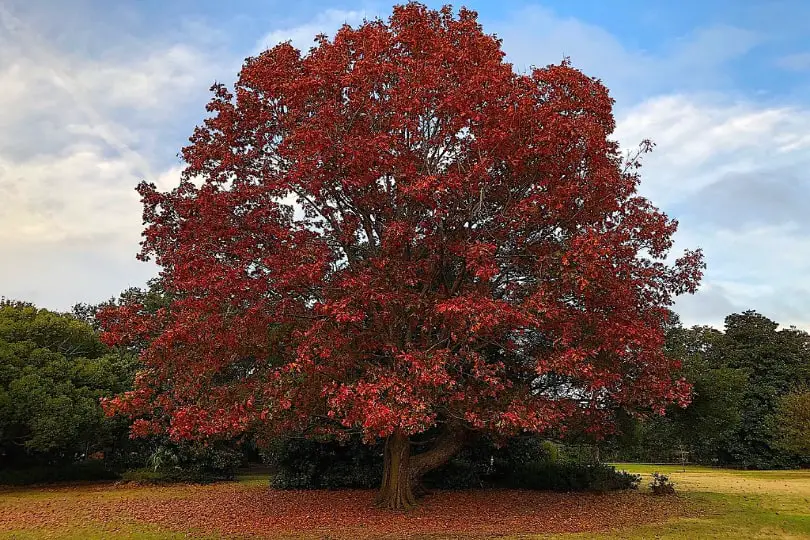
- Scientific Name: Quercus falcata Michx.
- Common Name(s): Southern Red Oak, Red Oak, Spanish Oak
- Mature Height: 70 to 80 feet (21 to 24 meters)
- Native Region: Eastern part of Oklahoma
- Flowers: Small and inconspicuous
- Uses: Suitable for rough lumber and furniture, the bark of the tree is rich in tannin, shade, or ornamental purposes.
The Southern Red Oak, scientifically known as Quercus falcata Michx., is a huge deciduous tree that can reach heights of 70 to 80 feet, with some individuals reaching even greater heights. It has a diameter of 2 to 3 feet and can be found in eastern Oklahoma.
The tree is distinguished by its broad, round, open crown and big spreading branches. The bark of the Southern Red Oak is rough, but not severely furrowed, and varies in color from light gray on younger trees to dark gray or nearly black on mature trees.
Southern Red Oak leaves have irregularly formed lobes that are typically thin and bristle-tipped. The central lobe is often the longest. The leaves are dark glossy green on top and downy gray on the bottom, making for a startling contrast during wind or rain storms.
While the leaves are unfolding in April, the tree produces little, inconspicuous blooms. The fruit is little spherical acorns about half an inch long that ripen in the second year. These acorns are arranged in a thin saucer-shaped cup with a short stem.
The Southern Red Oak is a valuable tree because of its timber and applications. The tree’s wood is heavy, durable, sturdy, and coarse-grained, making it less susceptible to faults than other oak species. It is widely used for rough lumber as well as furniture such as chairs and tables. The tree is highly suited to timber production, particularly in places with poorer and drier soils. Furthermore, the bark of the Southern Red Oak is high in tannin, which has a variety of applications.
The Southern Red Oak is highly valued in Oklahoma settings for its disease resistance, thrifty growth, huge and attractive form, and long life. It is frequently grown for shade or as a decorative. During the establishment phase of the Southern Red Oak in Oklahoma, it is critical to give it well-drained soil and plenty of water.
The tree is believed to be low-maintenance and thrives in full sun or partial shade. Pruning should be done regularly to eliminate dead or damaged branches and preserve a pleasant shape.
10. Swamp White Oak
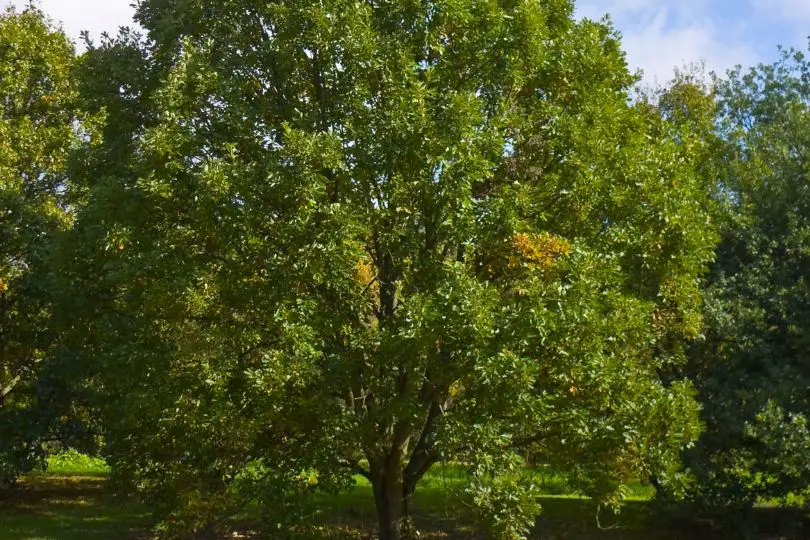
- Scientific Name: Quercus bicolor Willd.
- Common Name(s): Swamp White Oak
- Mature Height: 50-80 feet (15-24 meters)
- Native Region: North America
- Flowers: No Flowers
- Fruit: Acorn, commonly in pairs, 1 inch long by two-thirds of an inch thick, enclosed in a thick narrow-shaped cup.
- Uses: The wood of the swamp white oak is heavy, hard, strong, and tough, making it suitable for furniture, cabinet work, flooring, cooperage, ties, fence posts, and fuel.
The swamp white oak (Quercus bicolor Willd.) is a tree that resembles the true white oak and is usually found in low grounds and bottomlands. It is mostly found in northeastern Oklahoma, where it grows with oaks, maples, ashes, and hickories.
The highly divided, grayish-brown bark of the swamp white oak has broad ridges and distinguishes it from other species.
This oak species’ leaves are generally pear-shaped, with a wedge-shaped base and wavy, indented margins. They are dark green and lustrous on top and grey and fluffy on the bottom. The leaves are around 5 to 6 inches long and 2 to 4 inches wide. While the leaves of the chestnut oak and swamp chestnut oak are similar, the shape and size of their acorns differ.
When it comes to acorns, the swamp white oak produces them in pairs and matures in just one season. The acorns are carried on slender stalks that range in length from 2 to 4 inches. The acorn is roughly 1 inch long and two-thirds of an inch thick, enclosed within a thick, narrow-shaped cup.
The wood of the swamp white oak is highly appreciated in terms of usage. It is as heavy, hard, powerful, and tough as pure white oak. As a result, it is useful for a wide range of applications, including furniture, cabinetry, flooring, cooperage (barrel making), ties, fence posts, and fuel.
The swamp white oak can be a useful addition to Oklahoma settings. It is well-adapted to the region’s different soil conditions due to its aptitude for growing in low grounds and bottomlands. It is crucial to remember, however, that this oak tree enjoys moist, well-drained soils. To avoid waterlogging, it is best to plant a swamp white oak in a location with excellent drainage.
Although this tree does not produce beautiful blossoms, its appealing foliage and acorns add to its aesthetic value. The rich green, glossy leaves contrast nicely with the grayish, fluffy undersides. The acorns are also useful as a natural ornament. The swamp white oak does not require regular trimming, but it is recommended to remove any dead, diseased, or damaged branches to maintain its general health and look.
11. Shin Oak
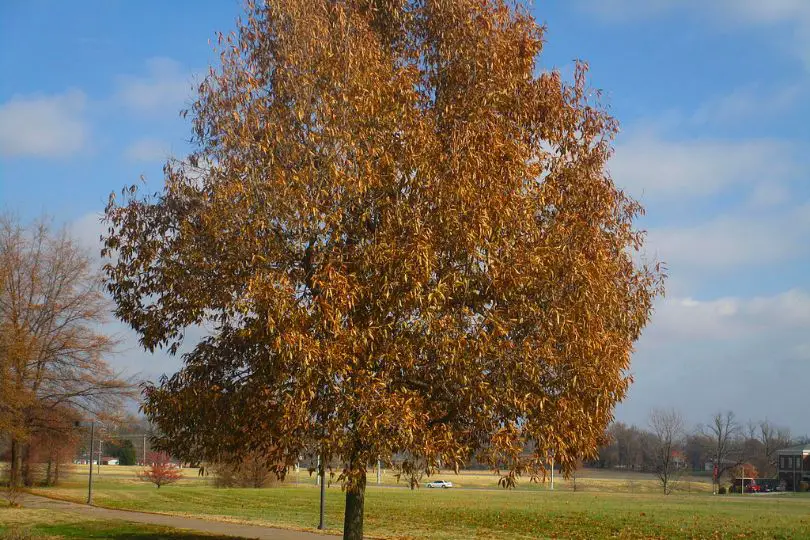
- Scientific Name: Quercus mohriana Buckl.
- Common Name(s): Shin Oak
- Mature Height: 10-20 feet (3-6 meters)
- Native Region: Western part of Oklahoma and the extreme western end of the Panhandle
- Flowers: No flowers
- Fruit: Acorns form in pairs or singly and are attached closely to the branchlets
- Uses: Mostly used for firewood
The Shin Oak, or Quercus mohriana Buckl., is a tiny tree with a spreading or bushy top. It is a semi-arid Southwest oak species found primarily in the western half of Oklahoma’s main body and the extreme western end of the Panhandle. Shin Oak bark is thin, heavily furrowed, and rough in texture.
The leaves of the Shin Oak are oblong, measuring 2 to 4 inches long and roughly an inch wide. They are thick and gray-green in hue, with wavy or serrated edges.
This species does not have any visible blooms. It does, however, bear fruit in the form of acorns. These acorns mature in a single season, and their cups enclose the small circular nuts for around half of their length. The bottom of the cup is thicker and rougher than the top or outside borders. Acorns grow in pairs or alone and are tightly linked to the branchlets.
The wood of the Shin Oak is largely utilized for firewood and has limited commercial value. It has not been widely examined due to its modest size and overall lower quality compared to other oak species.
The Shin Oak is a good alternative for individuals searching for a small tree with a spreading or bushy habit in Oklahoma environments. It is well-suited to the Southwest’s semi-arid climate, making it a hardy alternative to Oklahoma’s climate. The thin and heavily wrinkled bark of the tree provides aesthetic appeal to the scene. The oblong, gray-green leaves with wavy or serrated margins add texture and color to the plant.
Because the Shin Oak does not produce flowers, it provides appeal mostly through its fruit, notably the acorns. Acorns, whether in pairs or alone, can attract wildlife to the landscape, such as squirrels and birds. Furthermore, because of its tiny stature, the Shin Oak is ideal for smaller settings or as an understory tree in bigger gardens.
When it comes to maintenance, the Shin Oak is a tough tree that can withstand dry environments. It is critical in Oklahoma to ensure that the tree has well-drained soil and receives adequate sunlight.
Regular watering during dry times will aid in the establishment of the tree, but it does not require excessive irrigation. Although some pruning may be required to maintain its shape, the Shin Oak has a naturally spread or bushy form.
12. Chinkapin Oak
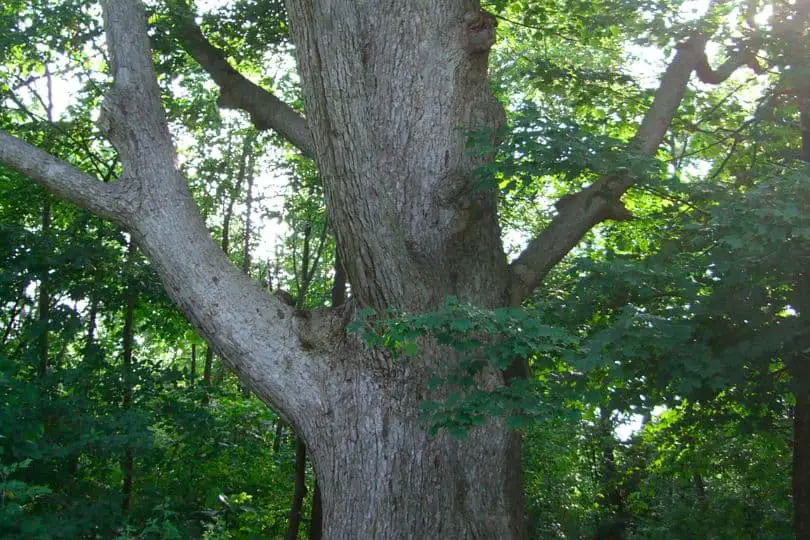
- Scientific Name: Quercus muehlenbergii
- Common Name(s): Chinkapin Oak, Yellow Chestnut Oak
- Mature Height: 40-60 feet (12-18 meters)
- Native Region: Eastern and Central United States
- Flowers: No Flowers
- Cones: Small acorns, usually solitary or in small clusters
- Uses: Provides shade, ornamental purposes, and wildlife habitat, acorns are consumed by wildlife
Chinkapin Oak, also known as Yellow Chestnut Oak, is a medium-sized deciduous tree that belongs to the oak family. It reaches a mature height of 40-60 feet (12-18 meters) and has a rounded crown with a sturdy trunk. This oak species is native to the eastern and central regions of the United States, including Oklahoma.
The Chinkapin Oak has dark green leaves with sharp, bristly teeth along the margin and a glossy upper surface. The leaves are simple and alternate, with a resemblance to chestnut leaves, hence the common name. The tree produces small acorns in the fall, which are usually solitary or in small clusters. These acorns are an important food source for various wildlife species.
In Oklahoma landscapes, the Chinkapin Oak is often planted for shade due to its broad crown. It also adds ornamental value to the surroundings with its unique leaf shape and attractive bark texture. The acorns produced by this oak tree are consumed by mammals such as squirrels, deer, and turkeys, providing wildlife habitat.
When grown in Oklahoma, Chinkapin Oaks thrive best in well-drained soils and full sun. They have good drought tolerance once established but can benefit from occasional watering during prolonged dry periods. Regular pruning is recommended to maintain a healthy structure and promote optimal growth.
13. Overcup Oak
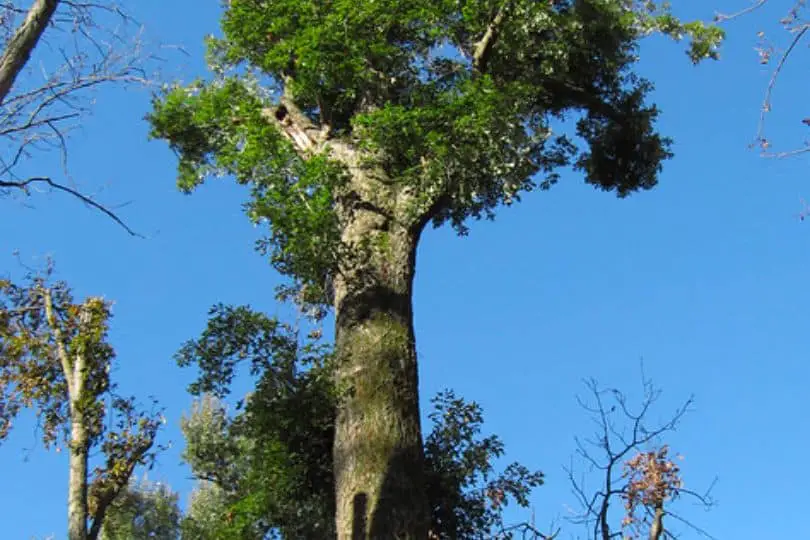
- Scientific Name: Quercus lyrata Walt.
- Common Name(s): Overcup Oak, Swamp White Oak, Water White Oak
- Mature Height: 60-80 feet (18-24 meters)
- Native Region: Southeastern United States
- Flowers: No Flowers.
- Uses: The wood of the Overcup Oak is heavy, hard, strong, and durable, making it suitable for various purposes similar to that of white oak. It can be used for construction, furniture, flooring, and barrels.
The Quercus lyrata Walt., or Overcup Oak, is a big tree with tiny, frequently pendulous branches. It’s also known as Swamp White Oak or Water White Oak. This oak species can grow to be 60-80 feet (18-24 meters) tall when mature. It is only found in the southeastern United States.
Overcup Oak leaves are oblong, ranging from 7 to 9 inches long and 1 to 4 inches wide. They have a dark green upper surface and are often pale underneath. During the fall, the leaves have 7 to 9 distinct pointed lobes and frequently turn a vivid scarlet or a combination of scarlet and orange. The bark of the tree is tough, flaky, and gray with a crimson tinge.
The Overcup Oak blossoms when its leaves open, but it does not produce flowers. Instead, it bears acorns as fruit, which mature during the first year. These acorns are enormous, spherical, or somewhat flattened, with a diameter of an inch or more and a height of half to one inch. A thickened elliptical or spherical cup that is nearly covering them eventually thins and frequently divides irregularly at the cup’s margin. This feature gives the tree its name.
The Overcup Oak thrives in damp, rich bottomland, indicating that it prefers well-drained soils with ample moisture in Oklahoma landscapes. Because of its natural range, it is best suited for southeastern Oklahoma.
This oak species can withstand flooding, making it excellent for moist environments. It’s a hardy tree that can provide shade and habitat for wildlife.
The wood of the Overcup Oak is highly regarded for its characteristics. It is heavy, robust, sturdy, and long-lasting, similar to white oak wood.
The wood is used in construction, such as beams, posts, and railroad ties. It can also be used to make furniture, flooring, and barrels for maturing wine and spirits.
14. Water Oak
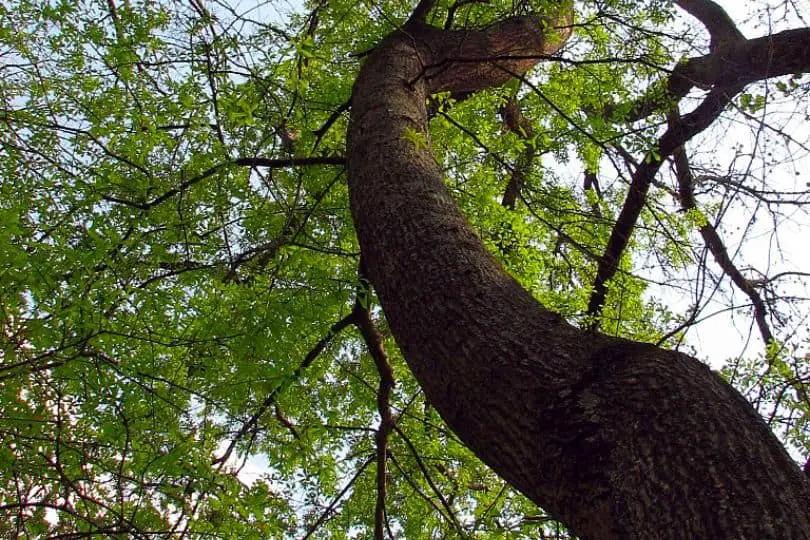
- Scientific Name: Quercus nigra L.
- Common Name(s): Water Oak
- Mature Height: 80 feet to over 3 feet in diameter
- Native Region: Eastern part of the State of Oklahoma
- Flowers: Flowers appear in April, small and not very noticeable.
- Fruit: Acorns, from half to two-thirds of an inch in length and nearly as broad
- Uses: Widely planted as a shade tree along streets and in parks. Wood is used for piling, crossties, and fuel.
The Water Oak, scientifically known as Quercus nigra L., is a natural oak found in the eastern part of Oklahoma near the borders of marshes and streams, as well as on rich bottom lands. It is often planted as a shade tree along streets and in parks in the southern states.
When completely mature, the Water Oak can reach a height of roughly 80 feet and a diameter of 1 to 3 feet. It has a slender trunk and smooth, light-brown bark with a red tinge that is ornamented with many smooth, thin scales.
The Water Oak’s leaves are simple and vary in shape, generally oblong with a larger apex and a smaller base, providing a wedge-shaped impression.
They are typically three-lobed on the outside, slender, and dull bluish-green in appearance. The leaves are typically smooth, paler on the underside than on the top, and are around 2 to 3 inches long and 1 to 1.5 inches wide. They stay green for a while before falling off the tree throughout the winter.
The Water Oak produces little, inconspicuous flowers in April, just as the leaves begin to emerge. The fruit, or acorns, of the tree, mature at the end of the second season. These acorns are usually half an inch to two-thirds of an inch long and about as wide. They are commonly striped and have a light brown or yellowish-brown tint. At the base, the acorns are contained in a narrow saucer-shaped cup.
Water Oak wood is heavy, durable, and sturdy, with a light brown tint and paler sapwood. While not widely used for lumber, the trees are harvested and used for piling, crossties, and fuel.
Because of its size and shape, the Water Oak can be a great shade tree in Oklahoma landscapes. It is ideal for planting along streets or in parks, where it will provide refreshing shade during the hot summer months. This tree thrives in damp places such as swamps or near streams, making it an excellent choice for well-drained soil. Once grown, it is low-maintenance and can endure mild drought conditions.
It is critical to give appropriate water during dry months for Water Oaks in Oklahoma, especially in the first few years after planting. Pruning should be done regularly to keep the tree structure balanced and healthy.
This oak type is generally resistant to pests and diseases, but it may be damaged by oak wilt or root rot on occasion. As a result, it is critical to monitor the tree’s health and seek professional help if any problems occur. Water Oak can grow and bring beauty and shade to Oklahoma landscapes for many years if properly cared for.
15. Willow Oak
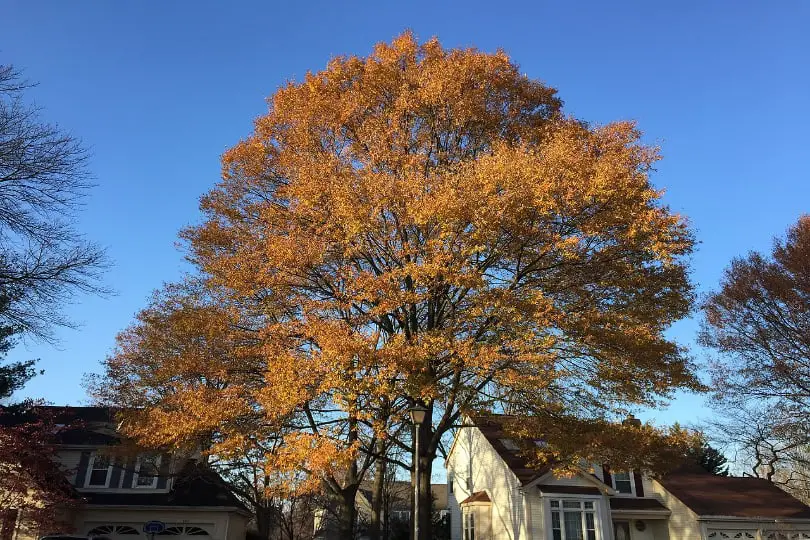
- Scientific Name: Quercus phellos L.
- Common Name(s): Willow oak
- Mature Height: 30-60 feet (9-18 meters)
- Native Region: Eastern part of the State, except on higher slopes and mountains
- Flowers: No Flowers
- Uses: Desirable for roadside, lawn, and park plantings; used for cross ties, bridge planks, barn sills, and general construction
The willow oak, sometimes known as water oak, is a long-lived tree found in eastern Oklahoma, particularly in lowlands and along river and marsh borders. It can also grow on fertile sandy uplands. Because of its attractive appearance and longevity, this tree is in high demand for roadside, lawn, and park plantings.
The willow oak is distinguished by its slender, willow-like leaves, which make it easy to spot in the forest. These leaves have a smooth or slightly wavy edge and are 2 to 4 inches long and 1⁄2 to 1 inch broad. They are bristle-pointed, smooth, light green, and shiny on top, but dull and usually smooth on the bottom. The leaves are borne on a short, sturdy stem and are placed alternately on the twig.
The bark of the willow oak is normally smooth and reddish-brown, but it becomes somewhat roughened and separated by tiny ridges as the tree ages.
The tree reproduces by producing little acorns that develop at the end of the second year. These acorns are about half an inch in diameter and are tightly packed along the stem. They have a light-brown hemisphere form, with a shallow, reddish-brown cup at the base. Blue jays, grackles, and other bird species, as well as rats, feed on the acorns.
In terms of wood consumption, willow oak is not often separated economically from other red oak species. The timber is dense, robust, and coarse-grained. It has a light brown color with a reddish tint, but it is not weather resistant. It is utilized locally for a variety of uses like cross ties, bridge planks, barn sills, and general construction.
When considering planting a willow oak in an Oklahoma environment, it is critical to select a spot that closely resembles its natural habitat. Lowlands, places near rivers or wetlands, and rich sandy uplands are examples. Willow oak grows best in full light and well-drained soil.
Regular irrigation is required to guarantee optimal growth, especially during dry months. It is also vital to prune the tree regularly to keep its shape and eliminate any dead or diseased limbs. With its willow-like leaves and appealing bark, the willow oak may make a lovely addition to the landscape if properly cared for.
16. Texas Oak
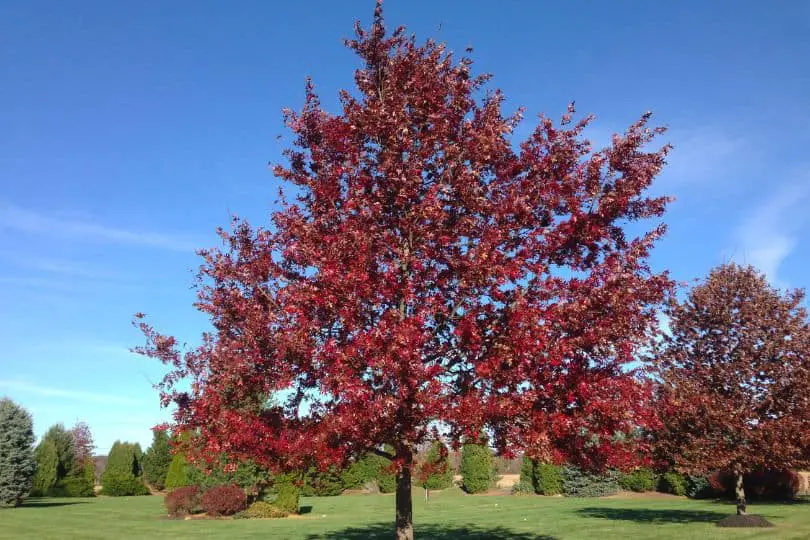
- Scientific Name: Quercus Shumardii var. Schneckii [Brit.] Sarg.
- Common Name(s): Spotted Oak, Texas Oak
- Mature Height: 100+ feet (30+ meters)
- Native Region: Eastern and Southern parts of Oklahoma
- Flowers: No Flowers
- Fruit: Small acorns, approximately 2/3 inch in diameter
- Uses: The wood of the Spotted Oak is heavy, hard, strong, and close-grained, making it suitable for various woodworking applications.
The Spotted Oak, sometimes known as the Texas Oak, is a tall and widespread oak found in eastern and southern Oklahoma. It is frequently confused with other oak species such as northern red oak, Spanish oak, and black oak. This tree thrives on mountain slopes, particularly on limestone soils, and prefers well-drained alluvial soils.
The Spotted Oak has a dark and rough bark that is separated into ridges and is 1 to 1.5 inches thick. While it is not a prominent species in most forest areas, solitary trees can be found. It can grow to a diameter of more than 3 feet and a height of more than 100 feet, but it is usually much smaller.
Spotted Oak leaves are simple, alternating, and measure 6 to 8 inches in length and 4 to 5 inches in breadth. They are generally seven-lobed, with each lobe being slightly lobed or having deep teeth.
The leaves are shiny on both sides, and they are decorated with enormous axillary tufts of light hairs. The leaf structure is similar to that of the scarlet oak, but it is smaller and more deeply lobed than that of the black oak.
The Spotted Oak produces little acorns that are about two-thirds of an inch in diameter and three-quarters of an inch long. These acorns have been placed in shallow cups. Spotted Oak wood is heavy, durable, sturdy, and close-grained, with a light reddish-brown color. It is widely utilized in a variety of woodworking applications.
To care for the Spotted Oak in Oklahoma landscapes, well-drained soil is important. Watering regularly, especially during dry spells, is critical to its general health. Mulching around the base of the tree aids in soil moisture retention and weed control.
Pruning may be required to keep the shape and remove dead or damaged branches. Regular pest and disease inspection is recommended for early detection and treatment of pests and diseases such as oak wilt and powdery mildew.
Spotted Oak is commonly used for building materials, furniture manufacture, and different wood crafts due to its strong, robust wood. Its excellent properties make it a popular choice for individuals looking for a sturdy and long-lasting wood substance.
Similar Articles
- Native Pine Trees In Oklahoma
- Native Maple Trees In Oklahoma
- Native Elm Trees In Oklahoma
- Common Palm Trees In Oklahoma
- Native Hickory Trees In Oklahoma
- Native Cedar Trees In Oklahoma
- Common Cherry Trees In Oklahoma
- Native Ash Trees In Oklahoma
- Common Birch Trees In Oklahoma
- Native Cypress Trees In Oklahoma
Native Oak Trees In Oklahoma – Sources
The Regional Gardening team makes sure that the information in our articles is accurate by only using sources that are known to be trustworthy. Some of these sources are peer-reviewed journals from government agencies, well-known universities, and scientific research organizations.
- Forest Tree Species, Oklahoma State University Extension
- Oklahoma Trees for Gardening Resource, Oklahoma State University Extension
- Oklahoma Native Trees by County, Oklahoma Forestry Services
- Native Plant Guide, Oklahoma County Conservation District
- Plants, Seeds & Landscapes, Oklahoma Native Plant Society
- Plant Selections for Oklahoma, Oklahoma State University Extension


